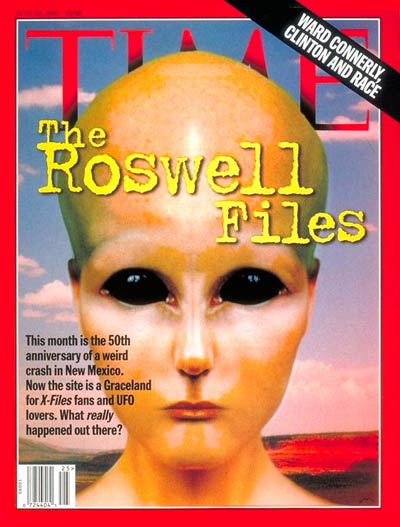
Odds are, if you’re familiar with the city of Roswell, N.M., you’re familiar with what happened there on this day, July 7, in 1947: a rancher named W.W. Brazel told Sheriff George Wilcox that he had found something strange on a sheep ranch northwest of the town. After finding bits of rubber, wood, foil, tape and paper in the field, the Sheriff called the local Army air field, which sent Major Jesse Marcel, an intelligence officer, to check it out. Marcel was convinced that Brazel stumbled upon nothing less than the remains of a flying saucer. He told his group commander, who told the press officer on duty, Walter Haut, who sent out a press release. The next day the Roswell Daily Record bore a headline—”RAAF CAPTURES FLYING SAUCER ON RANCH IN ROSWELL REGION”—that instantly turned the town into the nation’s UFO capital.
But there’s a big hitch in that oft-told tale. As TIME reported in an investigation on the 50th anniversary of the incident, the same day that the Daily Record ran the sensational story, it was determined that the litter was from a destroyed weather balloon. The paper printed a follow-up retraction the next day, and Brazel stated that he was embarrassed to have gotten so worked up over nothing.
That should have been that. But not everyone bought the official explanation, as TIME explained in 1997:
Enter Stanton Friedman, a former itinerant nuclear physicist now living in New Brunswick, Canada, who has long been, in his words, “a clear-cut, unambiguous UFOlogist.” In 1978, while waiting in a Baton Rouge, La., television station for an interview, Friedman was told that Jesse Marcel, long retired from the Air Force and living nearby, had once handled the wreckage of a UFO. After quizzing Marcel, who still believed the debris he retrieved was extraterrestrial, Friedman reviewed the old stories about Roswell, painstakingly sought out and interviewed other witnesses, and came to a dramatic conclusion: there had been a cover-up of “cosmic Watergate” proportions. His research and conclusions became the basis of the 1980 book The Roswell Incident, co-written by Charles Berlitz (author of The Bermuda Triangle) and UFO investigator William Moore. Its publication put Roswell back on the map.
The next decades saw the publication of several more Roswell books. Public awareness of the supposed cover-up grew to a point that the Air Force did its own investigation, eventually making public details of a top-secret balloon-tracking project that had been going on during that 1947 period and which they said explained the original wreckage.
Others clung to their belief that it was a flying saucer—including Walter Haut. Haut, who died in 2007 without ever giving up on the idea of the alien landing, was one of the founders of the city’s UFO Museum.
Read the 1997 cover story about Roswell, here in the TIME Vault: The Roswell Files
More Must-Reads from TIME
- Cybersecurity Experts Are Sounding the Alarm on DOGE
- Meet the 2025 Women of the Year
- The Harsh Truth About Disability Inclusion
- Why Do More Young Adults Have Cancer?
- Colman Domingo Leads With Radical Love
- How to Get Better at Doing Things Alone
- Michelle Zauner Stares Down the Darkness
Write to Lily Rothman at lily.rothman@time.com